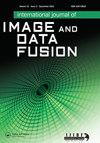基于高斯过程回归的Landsat 8和Sentinel 1A观测资料估算甘蔗叶面积指数和生物量
IF 1.8
Q3 REMOTE SENSING
International Journal of Image and Data Fusion
Pub Date : 2022-03-25
DOI:10.1080/19479832.2022.2055157
引用次数: 6
摘要
利用遥感技术准确估算大面积叶面积指数(LAI)和生物量等作物参数,对于监测作物生长和预测产量至关重要。本研究采用高斯过程回归(GPR)方法,利用光学和合成孔径雷达(SAR)数据融合估算甘蔗生长季节LAI和生物量值。利用GPR和光学、SAR综合指标在独立试验数据集上预测LAI具有较好的预测精度;基于径向基函数(均方根误差[RMSE] = 0.34,平均绝对误差[MAE] = 0.28,平均绝对百分比误差[MAPE] = 10.5%)和多项式函数(RMSE = 0.42, MAE = 0.31, MAPE = 12.58%)的GPR。甘蔗生物量的试验结果也表明,GPR (poly)的统计结果最高(RMSE = 2.45 kg/m2, MAE = 1.72 kg/m2, MAPE = 8.1%)。研究结果表明,基于光学和SAR数据融合和GPR的作物生物物理反演方法可以提高LAI和生物量估算,有助于有效的作物生长监测和制图应用。本文章由计算机程序翻译,如有差异,请以英文原文为准。
Estimating Leaf Area Index and biomass of sugarcane based on Gaussian process regression using Landsat 8 and Sentinel 1A observations
ABSTRACT Accurate estimation of crop parameters, such as Leaf Area Index (LAI) and biomass over large areas using remote sensing techniques, is crucial for monitoring crop growth and yield prediction. In this study, a Gaussian Process Regression (GPR) method was developed to estimate LAI and biomass values of sugarcane during growth season using optical and synthetic-Aperture Radar (SAR) data fusion. Predicting LAI on an independent test data set using the GPR and the combined optical and SAR indices provided better prediction accuracies of LAI; with the GPR based on radial basis function (Root Mean Square Error [RMSE] = 0.34, Mean Absolute Error [MAE] = 0.28 and Mean Absolute Percentage Error [MAPE] = 10.5%) and polynomial function (RMSE = 0.42, MAE = 0.31 and MAPE = 12.58%), respectively. The test results of sugarcane biomass also showed that the GPR (poly) produced the highest statistical results (RMSE = 2.45 kg/m2, MAE = 1.72 kg/m2, MAPE = 8.1%) using the combined indices. The results suggest that the crop biophysical retrieval based on optical and SAR data fusion and GPR proposed in this study could improve LAI and biomass estimation that could help for effective crop growth monitoring and mapping applications.
求助全文
通过发布文献求助,成功后即可免费获取论文全文。
去求助
来源期刊

International Journal of Image and Data Fusion
REMOTE SENSING-
CiteScore
5.00
自引率
0.00%
发文量
10
期刊介绍:
International Journal of Image and Data Fusion provides a single source of information for all aspects of image and data fusion methodologies, developments, techniques and applications. Image and data fusion techniques are important for combining the many sources of satellite, airborne and ground based imaging systems, and integrating these with other related data sets for enhanced information extraction and decision making. Image and data fusion aims at the integration of multi-sensor, multi-temporal, multi-resolution and multi-platform image data, together with geospatial data, GIS, in-situ, and other statistical data sets for improved information extraction, as well as to increase the reliability of the information. This leads to more accurate information that provides for robust operational performance, i.e. increased confidence, reduced ambiguity and improved classification enabling evidence based management. The journal welcomes original research papers, review papers, shorter letters, technical articles, book reviews and conference reports in all areas of image and data fusion including, but not limited to, the following aspects and topics: • Automatic registration/geometric aspects of fusing images with different spatial, spectral, temporal resolutions; phase information; or acquired in different modes • Pixel, feature and decision level fusion algorithms and methodologies • Data Assimilation: fusing data with models • Multi-source classification and information extraction • Integration of satellite, airborne and terrestrial sensor systems • Fusing temporal data sets for change detection studies (e.g. for Land Cover/Land Use Change studies) • Image and data mining from multi-platform, multi-source, multi-scale, multi-temporal data sets (e.g. geometric information, topological information, statistical information, etc.).
 求助内容:
求助内容: 应助结果提醒方式:
应助结果提醒方式:


